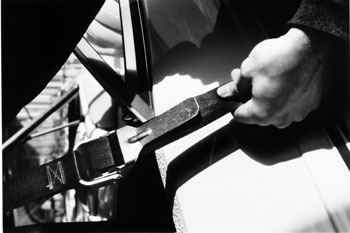 by Eddie Joe Risk
by Eddie Joe Risk
There are many styles and brands of tie downs to choose from. How can a boater know which ones have a reliable design and are built with quality materials that will last in the harsh marine environment?
We at Epco would like to help provide an answer. We have been manufacturing tie downs for 30 years and are familiar with the design and materials necessary to produce a rugged tie down that can safely trailer a boat for many years.
Quality starts with hardware. Tie downs should include a cam-over locking device that keeps tension in the webbing, so that the boat and the trailer are virtually inseparable. Yet, such device will allow a bit of "give" when necessary. The tie down handle typically serves as a cam-over binder that applies and locks the proper tension on the webbing.
Nearly as important as hardware is padding. Transom and gunwale tie downs should include padding on the back of hardware to protect the boat’s superstructure and hull from scratches. All hardware should be coated or plated with a rust-resistant material for a longer lasting life.
Most tie downs have webbing made of nylon or polypropylene. Both are good for towing purposes, though polypropylene is more flexible and nylon is stronger. Epco also offers a patented, weather-resistant webbing called Absorb-Edge which features a vertically-woven center to bear the weight load. The outside edges are woven horizontally to absorb side impacts for longer wear. They may even be cut on the edges where normal webbing will actually rip apart under pressure.
Higher-grade tie downs include Velcro fingers located close to the hardware. These enable the boater to secure excess webbing, so it won’t flap in the wind and possibly damage the boat’s finish.
Tie downs with these important materials and design features should last for many years and help prevent accidents or damage to the tailered boat. We hope that, armed with this information, boaters are better able to protect their boating investment.
From Epco, 423 7th St., Prosser, WA 99350.
All contents are copyright (c) 1998 by Northern Breezes, Inc. All information contained within is deemed reliable but carries no guarantees. Reproduction of any part or whole of this publication in any form by mechanical or electronic means, including information retrieval is prohibited except by consent of the publisher.